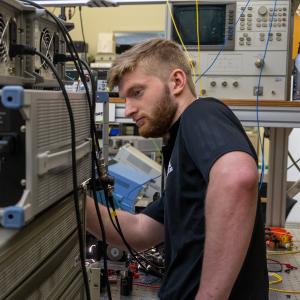Joel Slaby

Some might say I grew up in the windy city, Chicago, braving the bitterly cold winters. Others may say the cornfields of southern Indiana or even Pittsburgh, the City of Bridges. I’ve spent enough time in all of these places to form incredible memories and deep connections, but the truth is Atlanta has become my home for more than six years.
I’m Joel, a 3rd-year electrical engineering graduate student in Dr. Stephen Ralph’s Lab with a particular research interest in integrated silicon photonics (SiP). I joined Georgia Tech for my undergrad and immediately jumped into the community. I started in a living-learning community, Grand Challenges, where we focused on working towards solutions to the “14 Grand Challenges for Engineering in the 21st Century.” These were lofty goals for naive freshmen, and yet the community created a critical environment for cultivating new ideas and fostering action toward those ideas. I also participated in EcoCar, a competition to convert a real gas car to a hybrid. These projects sparked my drive to directly engage with industry and convert the technical knowledge from engineering classes to tangible technological developments. As far as I knew, I was set on graduating and going straight to industry.
However, I refused to end my undergrad career without a taste of research and thus joined Dr. Ralph’s lab during my final year after thoroughly enjoying one of his classes. Here I was immediately placed on a project to develop new silicon photonic designs using density-based topology optimization, a design method my colleague and mentor, Dr. Alec Hammond, pioneered here at Tech. This project was practical, the designs are fabricated at commercial foundries, cutting edge, current state-of-the-art design methodology, and impactful, active interest by universities and companies globally for developments in this field. Needless to say, I was hooked, and decided to stay for my master’s and shortly after, my PhD.
I love to move around and experience new places. I believe it keeps the world fresh and encourages a diversity of mind. But I decided to stay at Georgia Tech and pursue my Ph.D. because of this lab and this research. My primary research goal is to continue the advancement of integrated silicon photonics from a lab experiment to commercial solutions. SiP generally stated, is the transition of optical systems from large discrete components to small integrated silicon chips. This technology benefits from widespread integration by taking advantage of standard silicon CMOS processes used for electronics. Improvements in SiP directly affect data centers, satellite technology, virtual reality, high-performance computing, and more. To that end, I deliver on a number of research projects including the design and characterization of SiP systems for harsh environments such as aerospace through an NSF project called EPICA. I also work on developing a repeatable, commercially viable, and open-source fiber attach process through a collaborative project with DARPA and industry partners (KANAGAWA). As SiP continues to advance, this research is critical to ensure its success and widespread adoption.
Finally, unlike what most people believe, it’s not all work and no fun in graduate school. One of my favorite hobbies is crafting escape room puzzles. Every now and then, often for special occasions like birthdays or graduations, I present a series of connected challenges to unsuspecting friends. These puzzles have previously included bar crawls with sequential challenges revealing the location of the next bar, or group challenges where individuals were separated and had to use walkie-talkies to communicate and solve the puzzles. So, whether you meet me in the lab or somewhere else, be prepared for a puzzle.
“You know you’re in the right place when at least once a week you think to yourself, ‘I can’t believe I get paid to do this’ and in the same week ‘I’m not paid enough for this’” — Dr. Stephen Ralph


